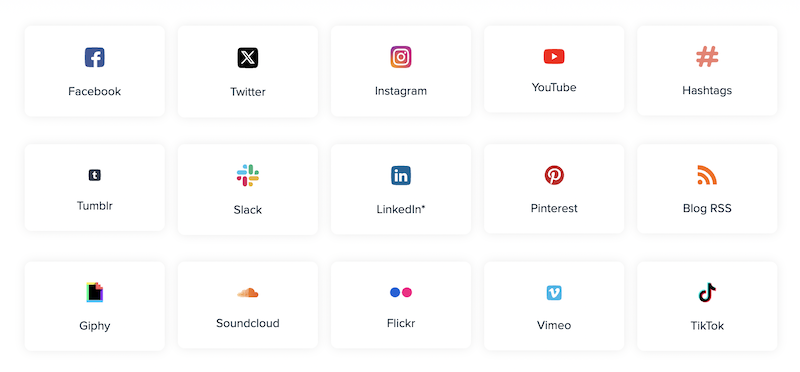Google reviews sitting on Google. Facebook recommendations staying on Facebook. LinkedIn testimonials buried in your profile.
Meanwhile, potential customers are on your website trying to make business decisions with zero customer feedback in sight.
This disconnect is costing you conversions every day. You’re collecting valuable insights from happy customers, then hiding them where prospects will never see them. It’s like having great salespeople locked in the back office during store hours.
The fix isn’t collecting more testimonials. It’s putting the ones you have where informed decisions actually happen.
If Your Testimonials Page Gets 2% of Your Traffic, Read This
Walk through any business website. You’ll find customer feedback in one of three places: buried on a testimonials page nobody visits, stuck in a footer widget that looks like decoration, or scattered across random product pages like afterthoughts.
None of this works because none of it feels alive.
A dedicated testimonials page feels like homework. Potential customers don’t visit these unless they’re already convinced–and by then, you’ve missed the influence window.
Social review display works differently. Instead of hoping prospects will hunt for customer satisfaction evidence, you put it where they’re already looking–homepage, pricing page, product pages.
“The difference between collecting reviews and converting with them comes down to placement, not volume. It’s better to have 5 reviews placed carefully than 500 in the footer of your website.”
Why Static Testimonials Actually Hurt Conversions
Sometimes social proof can backfire. A bad social review display doesn’t just fail to convert–it actively destroys trust. When prospects land on your site and immediately spot fake or manipulative customer feedback, they bounce faster than if you had no testimonials at all.
Here’s what’s killing your credibility:
Fake testimonials scream fabricated. “John D.” with no photo, generic location, and praise that sounds like marketing copy triggers immediate skepticism. Real customer feedback includes specifics, minor complaints, and feels conversational.
Perfect numbers feel manufactured. Exactly 1,000 reviews? Really? Authentic customer satisfaction data includes messy, realistic numbers like 1,247 reviews or 4.3-star ratings. Round numbers suggest manipulation.
Generic praise tells prospects nothing. “Great product!” doesn’t address purchase concerns or help potential customers make informed decisions. Useful customer feedback insights mention specific features, use cases, or problem resolution.
Overwhelming clutter competes for attention. Fifteen different social proof elements create decision paralysis instead of confidence. Strategic placement means choosing the right testimonial for the right moment, not showcasing everything everywhere.
Outdated mentions signal stagnation. Press coverage from 2019 or old customer feedback suggests your business peaked years ago. Fresh social review display shows ongoing customer choice and satisfaction.
The psychology behind the failure is simple: we look to others for behavioral cues, but only when those cues feel authentic. Manufactured social proof triggers skepticism instead of confidence, increasing bounce rates and damaging brand credibility.
Review display integration works because it pulls customer feedback from multiple sources where manipulation is harder. Google reviews, Facebook recommendations, and social media mentions feel more credible than website testimonials because they exist independently of your marketing efforts.
What Review Aggregation Actually Solves
Customer feedback insights displayed dynamically across your website feel authentic and immediate. When someone sees reviews mixed with Facebook recommendations and social media mentions in one feed, they’re not just reading testimonials–they’re seeing comprehensive proof that real people choose your business.
Multiple sources create authenticity that single-platform displays can’t match. A review aggregator pulls this scattered praise into one visual feed that updates automatically. Set it up once, let it run.
Juicer handles review display integration across 15+ platforms, including Facebook, LinkedIn, Instagram, and others. Setup takes minutes, not hours. The features include automatic moderation, custom styling, and real-time updates without developer involvement.
“When customer feedback updates automatically from multiple sources, it creates the sense that people are actively choosing your business right now.”
Where Social Review Display Actually Drives Sales
Performance improves when you stop treating reviews like content and start treating them like conversion tools. Display reviews where friction happens, not where you think they belong organizationally.
Your homepage needs a social review display because first impressions matter. When someone lands on your site for the first time, they’re asking: “Can I trust this company?” Recent customer feedback answers that question immediately.
Your pricing page needs customer feedback insights because cost concerns require trust. When someone’s evaluating whether your service is worth the money, seeing that others made the same choice and were satisfied removes hesitation.
Your contact forms need recent ratings because people hesitate before sharing information. A live feed of customer satisfaction data next to your contact form shows that other people trusted you with their details and had positive experiences.
Potential customers need social proof at specific moments: when they’re comparing options, when they’re about to connect or purchase, when they’re hesitating on a contact form.
“Conversion happens when prospects see that other people are actively choosing you, not when they read testimonials that feel like marketing copy.”
Technical Setup That Actually Works
Review display integration doesn’t require coding skills or developer resources. Modern aggregators handle the technical complexity while giving you control over appearance and placement.
Connect your Google Business account, Facebook page, and relevant industry platforms. The tools pull recent customer feedback automatically and format it for website display. You customize colors, layouts, and filtering without touching code.
Juicer simplifies this entire process with drag-and-drop customization and live preview features. You can test different layouts, adjust ratings display styles, and customize filtering rules without affecting your live website. The platform integrates with any CMS–WordPress, Shopify, Webflow–through simple embed codes that work immediately.
Features that matter for business decisions: automatic updates, spam filtering, ratings display, and mobile optimization. The system should enhance your existing website design, not fight against it.
Users can explore different layouts and find what works best for their audience without technical expertise.
Why Juicer Outperforms Static Review Widgets
Generic review widgets pull from single sources and update infrequently. Juicer aggregates customer feedback from multiple sources and refreshes automatically, creating social proof that feels current rather than stale.
The platform’s moderation tools let you enhance quality without manual effort. Automatic spam filtering, keyword-based aggregators, and whitelist features ensure your social review display maintains professional standards while staying authentic.

Performance tracking built into Juicer helps you uncover which customer feedback drives the most engagement. Analytics show click-through rates, time spent viewing reviews, and conversion attribution–data most review tools don’t provide.
“The goal isn’t just to show reviews – it’s to show the right reviews to the right people at the right moment in their decision process.”
Smart Filtering Without Losing Authenticity
Valuable insights come from showing the right feedback to the right people. Review aggregators with smart filtering help you demonstrate relevant customer satisfaction without overwhelming visitors.
Customize what appears based on page context. Product pages should show product-specific reviews. Service pages should showcase relevant client feedback. Homepage displays should represent your overall customer satisfaction levels.
Respond to negative feedback constructively–but don’t let it dominate your social proof display. Aggregators with moderation features let you maintain quality without manual effort from your team.
Mixed ratings (mostly positive with some constructive feedback) actually build more trust than perfect ratings, which can feel manufactured.
“Smart review curation means showing authentic feedback that addresses real concerns, not just collecting five-star ratings.”
How Juicer Handles Multi-Platform Review Aggregation
Most businesses struggle with customer feedback scattered across Google, Facebook, industry review sites, and social media. Juicer solves this by pulling multiple sources into one cohesive feed that updates without manual intervention.
The platform connects to Google Business profiles, Facebook pages, LinkedIn company pages, and more. Customer satisfaction data flows automatically into your website display, maintaining constant brand presentation across all customer feedback.

Juicer’s filtering system lets you showcase relevant reviews based on page context. Product pages can display product-specific customer feedback, while service pages show relevant client testimonials. The tools enhance relevance without requiring constant team management.
Features like automatic photo integration, ratings display customization, and responsive design ensure your social review display works across all devices. Visitors see compelling customer feedback insights, whether they’re browsing on mobile or desktop.
Industry-Specific Applications
Professional Services: Building Credibility Through Client Voices
Legal practices, medical offices, and consulting firms face unique trust challenges. Potential customers need proof that you’re competent, reliable, and worth premium fees before they’ll connect with sensitive information or important projects.
Customer feedback insights for professional services should address decision-maker concerns: expertise depth, communication quality, and results delivery. Display reviews that mention specific outcomes, process satisfaction, and professional competence.
Google reviews mixed with LinkedIn recommendations create comprehensive credibility. Legal clients might praise case outcomes on Google while colleagues endorse expertise on LinkedIn. Review aggregation combines these perspectives into compelling social proof.
Place social review display on contact and about pages where prospects evaluate whether to reach out. Service pages benefit from customer feedback that addresses specific practice area concerns–family law testimonials for family law pages, corporate feedback for business services.
Professional services websites should showcase customer satisfaction data that demonstrates both competence and care. Reviews mentioning responsiveness, clear communication, and successful outcomes address the primary concerns prospects have before engaging professional services.
Ecommerce: Turning Browsers Into Buyers
Ecommerce operations need social review display that addresses the specific friction points of online shopping: product quality uncertainty, sizing concerns, and shipping anxiety.
Customer feedback with photos performs significantly better than text-only testimonials because visual proof bridges the gap between product photography and real-world use. When someone sees your product being used by real people in real situations, purchase confidence increases immediately.
Review integration on product detail pages should showcase customer feedback that addresses common objections. Sizing reviews for clothing, durability feedback for electronics, and styling inspiration for home goods all help potential customers make informed decisions.

The key is contextual relevance. Product-specific pages should only show customer satisfaction data related to that item. Collection pages can include broader customer feedback that demonstrates brand quality and service excellence.
Shopping cart and checkout pages benefit from social review display that addresses purchase completion concerns: shipping speed, packaging quality, and return policy satisfaction. Customer feedback insights about positive shopping experiences reduce cart abandonment at critical moments.
B2B Software: Proving Value Before Trial
B2B software companies face longer sales cycles and multiple decision makers. Social review display needs to address ROI concerns, implementation complexity, and long-term partnership value across different stakeholder priorities.
Customer satisfaction data for software should include specific use case examples, integration experiences, and measurable outcomes. Display reviews from similar company sizes or industries to help prospects see relevant success stories.
Technical decision makers need customer feedback about ease of implementation, system reliability, and support quality. Business decision makers want proof of ROI, productivity improvements, and team adoption success.
Review aggregation from platforms like G2, Capterra, and industry-specific review sites builds more credibility than website testimonials alone. These platforms verify purchaser status and prevent fake reviews, making feedback more trustworthy.
Landing pages and pricing pages should showcase customer feedback insights that address specific concerns prospects have at those stages. Trial signup pages benefit from reviews about quick setup and immediate value recognition.
Local Businesses: Demonstrating Community Connection
Local businesses–restaurants, gyms, service providers–need a social review display that demonstrates both quality and community engagement. Potential customers want proof that you’re active, popular, and consistently delivering good experiences.
Google reviews mixed with social media mentions create compelling social proof that feels immediate and authentic. Recent customer feedback about service quality, combined with social posts showing busy, happy customers, demonstrates ongoing success.
Location-based customer satisfaction data matters most for local businesses. Showcase customer feedback that mentions specific locations, local staff members, or community connections that resonate with area prospects.
Social review display visible from storefronts or in waiting areas extends the impact beyond digital channels. Potential customers can see social proof while deciding whether to enter or while waiting for service.
Review integration should connect online presence with physical location experience. Customer feedback that mentions both online interaction and in-person service helps prospects understand your complete service approach.
Measuring What Moves Revenue
Performance metrics for review display integration go beyond vanity numbers. Track conversion rates on pages with social proof versus pages without. Discover which customer feedback types drive the most engagement.
Revenue attribution matters most: measure revenue connected to pages with integrated reviews. Users who engage with customer feedback displays typically convert at higher rates than visitors who skip past static testimonials.
Uncover patterns in which reviews drive action. Product-specific customer feedback might work better on product pages, while service testimonials might enhance contact form conversions.
The goal isn’t just to showcase positive feedback–it’s to use customer satisfaction data to remove friction from your sales process and help potential customers make informed decisions faster.
“The best review display integration doesn’t just prove you’re good–it proves you’re the right choice for this specific customer right now.”
Start Converting Your Reviews Into Revenue
Your customer feedback is already out there. The question is whether you’re using it strategically or letting it sit unused while potential customers make business decisions without social proof.
Review display integration isn’t about collecting more testimonials–it’s about putting the ones you have to work where they actually influence sales. The tools exist, the setup is straightforward, and the performance impact is measurable.
Join Smart Brands Using Juicer
Ready to turn scattered customer satisfaction data into conversion-focused social proof? Try Juicer free for 14 days and see how social review display changes your conversion rates.
Frequently Asked Questions
Q: How do you prioritize review display integration against other conversion optimization projects?
Review display integration typically delivers faster ROI than most CRO projects because you’re working with existing assets rather than creating new content. If you’re already collecting customer feedback but seeing low conversion rates on high-traffic pages, this should be a priority. The setup effort is minimal compared to redesigning landing pages or running extensive A/B tests, but the performance impact often matches more complex optimization projects.
Q: What’s the best way to measure ROI specifically from review integration, not just overall conversion improvement?
Track conversion rates on pages before and after adding social review display, but also measure engagement metrics specific to the review content–time spent viewing, click-through rates on review elements, and scroll depth to review sections. Advanced analytics should show you revenue attribution to visitors who interacted with customer feedback versus those who didn’t. Juicer’s performance tracking helps you uncover which specific customer satisfaction content drives the most business decisions.
Q: How do you handle negative reviews strategically without hiding authentic feedback?
Smart review aggregators let you demonstrate transparency while maintaining quality. Display reviews that show you respond constructively to concerns–this actually builds more trust than perfect ratings. Use filtering to showcase negative feedback that you’ve addressed well, rather than hiding all criticism. Mixed reviews with thoughtful responses build more credibility than perfect scores, especially when prospects can see how your business learns from feedback.
Q: For businesses with multiple locations or product lines, how do you prevent review displays from becoming irrelevant or overwhelming?
Customize review feeds based on page context and location data. Product-specific pages should only show relevant customer feedback, while location pages should integrate geographically relevant Google reviews. Advanced tools like Juicer let you create multiple feeds with different filtering rules–one for each location or product category–without managing separate accounts. The key is ensuring potential customers see customer satisfaction data that matches their specific situation.
Q: When does review integration make sense for B2B companies versus B2C, and how should the approach differ?
B2B review display integration should focus on decision-maker concerns: ROI, implementation complexity, support quality, and long-term partnership value. Showcase customer feedback from similar company sizes or industries, and integrate case study mentions alongside traditional reviews. B2C approaches can be more volume-focused and emotion-driven. B2B visitors need data-driven decision support, while B2C visitors need trust and social validation. The technical setup stays the same, but filtering and presentation should match how each audience makes informed decisions.




